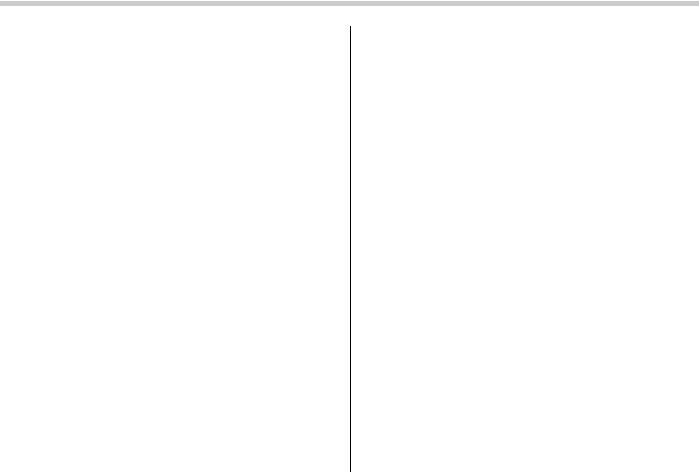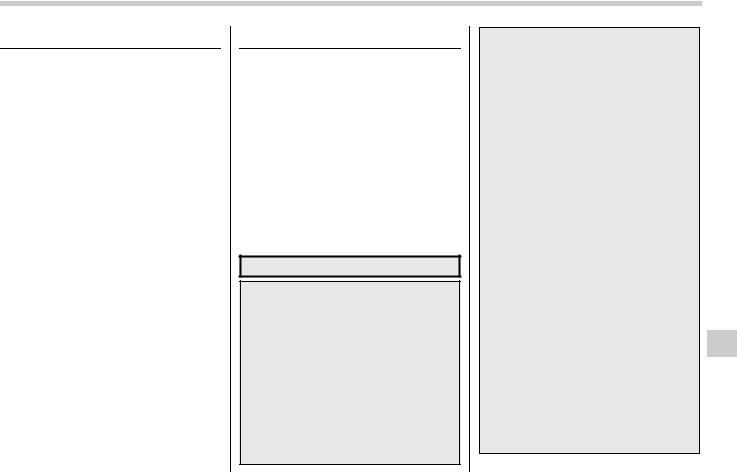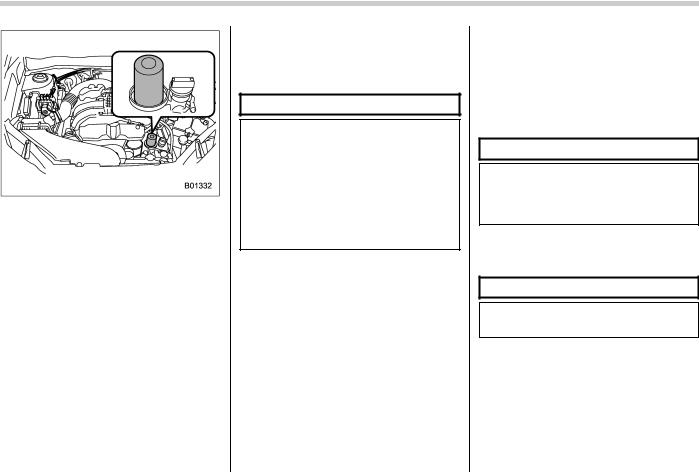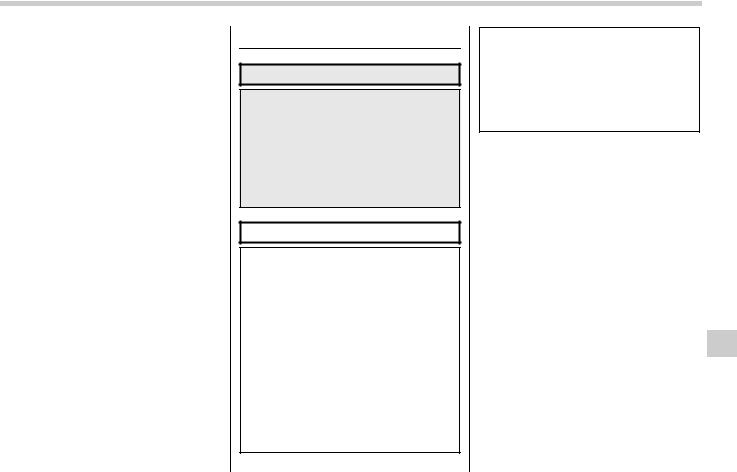Subaru Forester 2014 Service Guide

Maintenance and service
Maintenance schedule ....................................... |
11-3 |
Maintenance precautions................................... |
11-3 |
Before checking or servicing in the engine |
|
compartment.................................................... |
11-4 |
When checking or servicing in the engine |
|
compartment while the engine is running.......... |
11-4 |
Engine hood ....................................................... |
11-5 |
Engine compartment overview.......................... |
11-6 |
Non-turbo models .............................................. |
11-6 |
Turbo models..................................................... |
11-7 |
Engine oil............................................................ |
11-8 |
Checking the oil level ......................................... |
11-8 |
Changing the oil and oil filter.............................. |
11-9 |
Recommended grade and viscosity .................. |
11-10 |
Synthetic oil..................................................... |
11-11 |
Cooling system ................................................ |
11-11 |
Cooling fan, hose and connections................... |
11-11 |
Engine coolant ................................................. |
11-12 |
Air cleaner element.......................................... |
11-13 |
Replacing the air cleaner element ..................... |
11-13 |
Spark plugs ...................................................... |
11-15 |
Recommended spark plugs .............................. |
11-15 |
Drive belts ........................................................ |
11-15 |
Manual transmission oil .................................. |
11-16 |
Recommended grade and viscosity .................. |
11-16 |
Continuously variable transmission fluid....... |
11-16 |
Front differential gear oil (CVT models) ......... |
11-16 |
Recommended grade and viscosity .................. |
11-16 |
Rear differential gear oil .................................. |
11-17 |
Recommended grade and viscosity .................. |
11-17 |
Brake fluid........................................................ |
11-17 |
|
Checking the fluid level.................................... |
11-17 |
|
Recommended brake fluid ............................... |
11-18 |
|
Clutch fluid (MT models)................................. |
11-18 |
|
Checking the fluid level.................................... |
11-18 |
|
Recommended clutch fluid............................... |
11-19 |
|
Brake booster .................................................. |
11-19 |
|
Brake pedal ...................................................... |
11-19 |
|
Checking the brake pedal free play .................. |
11-19 |
|
Checking the brake pedal reserve distance....... |
11-20 |
|
Clutch pedal (MT models) ............................... |
11-20 |
|
Checking the clutch function............................ |
11-20 |
|
Checking the clutch pedal free play.................. |
11-20 |
|
Hill start assist system.................................... |
11-21 |
|
Replacement of brake pad and lining ............ |
11-21 |
|
Breaking-in of new brake pads and linings ....... |
11-21 |
|
Parking brake stroke ....................................... |
11-22 |
|
Tires and wheels.............................................. |
11-22 |
|
Types of tires................................................... |
11-22 |
|
Tire pressure monitoring system (TPMS) (if |
|
|
......................................................equipped) |
11-23 |
11 |
Tire inspection................................................. |
11-24 |
|
..................................Tire pressures and wear |
11-24 |
|
Wheel balance ................................................. |
11-26 |
|
Wear indicators ............................................... |
11-27 |
|
Tire rotation direction mark.............................. |
11-27 |
|
Tire rotation..................................................... |
11-28 |
|
Tire replacement.............................................. |
11-28 |
|
Wheel replacement .......................................... |
11-29 |
|
Aluminum wheels ............................................ |
11-29 |
|

Maintenance and service
Windshield washer fluid .................................. |
11-30 |
Replacement of wiper blades.......................... |
11-31 |
Windshield wiper blade assembly ..................... |
11-32 |
Windshield wiper blade rubber ......................... |
11-32 |
Rear window wiper blade assembly .................. |
11-33 |
Rear window wiper blade rubber....................... |
11-34 |
Battery............................................................... |
11-35 |
Fuses ................................................................ |
11-36 |
Installation of accessories............................... |
11-37 |
Replacing bulbs ............................................... |
11-38 |
Headlights (models with HID headlights) ........... |
11-38 |
Headlights (models without HID headlights)...... |
11-38 |
Front turn signal light, front side marker light |
|
and parking light ........................................... |
11-39 |
Parking light.................................................... |
11-40 |
Front fog light (if equipped).............................. |
11-40 |
Rear combination lights ................................... |
11-40 |
License plate light ........................................... |
11-41 |
Other bulbs ..................................................... |
11-42 |
Battery replacement ........................................ |
11-42 |
Replacing access key battery........................... |
11-43 |
Replacing transmitter battery ........................... |
11-43 |

Maintenance schedule
The scheduled maintenance items required to be serviced at regular intervals are shown in the “Warranty and Maintenance Booklet”.
For details of your maintenance schedule, read the separate “Warranty and Maintenance Booklet”.
NOTE
For models with a multi function display, you can set a reminder to be displayed when a scheduled maintenance item is almost due. For details, refer to “Maintenance settings” F3-66.
Maintenance and service/Maintenance schedule 11-3
Maintenance precautions
When maintenance and service are required, it is recommended that all work be done by an authorized SUBARU dealer.
If you perform maintenance and service by yourself, you should familiarize yourself with the information provided in this section on general maintenance and service for your SUBARU.
Incorrect or incomplete service could cause improper or unsafe vehicle operation. Any problems caused by improper maintenance and service performed by you are not eligible for warranty coverage.
 WARNING
WARNING
. Always select a safe area when performing maintenance on your vehicle.
. Always be very careful to avoid injury when working on the vehicle. Remember that some of the materials in the vehicle may be hazardous if improperly used or handled, for example, battery acid.
. Your vehicle should only be serviced by persons fully competent to do so. Serious personal injury
may result to persons not experienced in servicing vehicles.
. Always use the proper tools and make certain that they are well maintained.
. Never get under the vehicle supported only by a jack. Always use safety stands to support the vehicle.
. Never keep the engine running in a poorly ventilated area, such as a garage or other closed areas.
. Do not smoke or allow open flames around the fuel or battery. This will cause a fire.
. Because the fuel system is under pressure, replacement of the fuel filter should be performed only by your SUBARU dealer.
. Wear adequate eye protection to guard against getting oil or fluids in your eyes. If something does get in your eyes, thoroughly wash them out with clean water.
. Do not tamper with the wiring of the SRS airbag system or seatbelt pretensioner system, or attempt to take its connectors apart, as that may activate the system or it can render it inop-
– CONTINUED –

11-4 Maintenance and service/Maintenance precautions
erative. NEVER use a circuit tester for this wiring. If your SRS airbag or seatbelt pretensioner needs service, consult your nearest SUBARU dealer.
&Before checking or servicing in the engine compartment
 WARNING
WARNING
. Always stop the engine and set the parking brake firmly to prevent the vehicle from moving.
. Always let the engine cool down. Engine parts become very hot when the engine is running and remain hot for some time after the engine has stopped.
. Do not spill engine oil, engine coolant, brake fluid or any other fluid on hot engine components. This may cause a fire.
. Always remove the key from the ignition switch. When the ignition switch is in the “ON” position, the cooling fan may operate suddenly even when the engine is stopped.
. Before performing any servicing
on a vehicle equipped with a remote engine start system (a dealer option) temporarily place that system in the service mode to prevent it from unexpectedly starting the engine.
 CAUTION
CAUTION
. Do not contact the drive belt cover while checking the components in the engine compartment. Doing so may cause your hand to slip off the cover and result in an unexpected injury.
. Do not touch the oil filter until the engine has cooled down completely. Doing so may result in a
burn or other injury. Note that the oil filter becomes very hot when the engine is running and remains hot for some time after the engine has stopped.
&When checking or servicing in the engine compartment while the engine is running
 WARNING
WARNING
A running engine can be dangerous. Keep your fingers, hands, clothing, hair and tools away from the cooling fan, drive belt and any other moving engine parts. Removing rings, watches and ties is advisable.

Engine hood
To open the hood:
1. If the wiper blades are lifted off the windshield, return them to their original position.
2. Pull the hood release knob under the instrument panel.
3.Release the secondary hood release by moving the lever between the front grille and the hood toward the left.
4.Lift up the hood.
To close the hood:
1.Lower the hood to a height of approximately 5.9 in (15 cm) above its closed position and then let it drop.
2.After closing the hood, be sure the hood is securely locked.
If this does not close the hood, release it from a slightly higher position. Do not push the hood forcibly to close it. It could deform the metal.
Maintenance and service/Engine hood 11-5
 WARNING
WARNING
Always check that the hood is properly locked before you start driving. If it is not, it might fly open while the vehicle is moving and block your view, which may cause an accident and serious bodily injury.

11-6 Maintenance and service/Engine compartment overview
Engine compartment overview
& Non-turbo models
1)Brake fluid reservoir/Clutch fluid reservoir (MT) (page 11-17)
2)Fuse box (page 11-36)
3)Battery (page 11-35)
4)Windshield washer tank (page 11-30)
5)Engine oil filler cap (page 11-8)
6)Engine coolant reservoir (page 11-12)
7)Radiator cap (page 11-12)
8)Engine oil filter (page 11-9)
9)Engine oil level gauge (page 11-8)
10)Air cleaner case (page 11-13)

Maintenance and service/Engine compartment overview 11-7
& Turbo models
1)Brake fluid reservoir (page 11-17)
2)Fuse box (page 11-36)
3)Battery (page 11-35)
4)Windshield washer tank (page 11-30)
5)Engine oil filler cap (page 11-8)
6)Engine coolant reservoir (page 11-12)
7)Radiator cap (page 11-12)
8)Engine oil filter (page 11-9)
9)Engine oil level gauge (page 11-8)
10)Air cleaner case (page 11-13)

11-8 Maintenance and service/Engine oil
Engine oil
NOTE
. The engine oil consumption rate is not stabilized, and therefore cannot be determined until the vehicle has traveled at least several thousand miles (kilometers). Even after break-in, when the vehicle is used under severe driving conditions such as those mentioned in the Warranty and Maintenance Booklet, engine oil is consumed or deteriorated more quickly than under normal driving conditions. If you drive your vehicle under these severe conditions, you should check the oil level at least at every second fuel fill-up time, and change the oil more frequently. Please refer to the Warranty and Maintenance Booklet for more details.
. If the oil consumption rate seems abnormally high after the break-in period, for example more than 1 quart per 1,200 miles or 1 liter per 2,000 kilometers, contact your SUBARU dealer.
& Checking the oil level
Check the engine oil level at each fuel stop.
1. Park the vehicle on a level surface and stop the engine. If you check the oil level just after stopping the engine, wait a few minutes for the oil to drain back into the oil pan before checking the level.
1)Oil level gauge
2)Oil filler cap
3)Oil filter
2.Pull out the level gauge, wipe it clean, and insert it again.
3.Be sure the level gauge is correctly inserted until it stops.
1)Full level
2)Low level
3)Approximately 1.1 US qt (1.0 liter, 0.9 Imp qt) from low level to full level
4.Pull out the oil level gauge again.
5.Check the oil levels on both sides of the level gauge. The engine oil level must be judged by the lowest of the two levels. If the oil level is below the low level mark, add oil so that the full level is reached.
 CAUTION
CAUTION
. Be careful not to touch the engine oil filter when removing the oil filler cap. Doing so may result in a burn, a pinched finger, or may cause some other injury.

. Use only engine oil with the recommended grade and viscosity.
. Be careful not to spill engine oil when adding it. If oil touches the exhaust pipe, it may cause a bad smell, smoke, and/or a fire. If engine oil gets on the exhaust pipe, be sure to wipe it off.
. If the level gauge is not pulled out easily, twist the level gauge right and left, then pull it out. Otherwise, you may be injured accidentally straining yourself.
To add engine oil, remove the engine oil filler cap and slowly pour engine oil through the filler neck. After pouring oil into the engine, you must use the level gauge to confirm that the oil level is correct.
NOTE
To prevent overfilling the engine oil, do not add any additional oil above the upper level when the engine is cold.
& Changing the oil and oil filter
 CAUTION
CAUTION
If you change your own oil, be sure to drain all the oil from the filter before disposal. Do not dispose of used engine oil by placing it in the trash, or by pouring it onto the ground, into sewers, or into any body of water. Check with your local government office for the proper disposal options available to you.
Change the oil and oil filter according to the maintenance schedule in the “Warranty and Maintenance Booklet”.
The engine oil and oil filter must be changed more frequently than listed in the maintenance schedule when driving on dusty roads, when short trips are frequently made, or when driving in extremely cold weather.
1.Warm up the engine by letting the engine idle for approximately 10 minutes to ease draining the engine oil.
2.Park the vehicle on a level surface and stop the engine.
3.Remove the oil filler cap.
Maintenance and service/Engine oil 11-9
4. Drain out the engine oil by removing the drain plug while the engine is still warm. The used oil should be drained into an appropriate container and disposed of properly.
 WARNING
WARNING
Be careful not to burn yourself with hot engine oil.
5. Wipe the seating surface of the drain plug with a clean cloth and tighten it securely with a new sealing washer after the oil has completely drained out.
– CONTINUED –

11-10 Maintenance and service/Engine oil
6.Remove the oil filter with an oil filter wrench.
7.Before installing a new oil filter, apply a thin coat of engine oil to the seal.
8.Clean the rubber seal seating area of the engine and install the oil filter by hand turning. Be careful not to twist or damage the seal.
9.Tighten the oil filter by the amount indicated in the following table after the seal makes contact with the seating surface.
Oil filter color |
Part number |
Amount of |
|
rotation |
|||
|
|
||
|
|
|
|
Black |
15208AA160 |
1 rotation |
|
|
|
|
 CAUTION
CAUTION
. Never over tighten the oil filter because that can result in an oil leak.
. Thoroughly wipe off any engine oil that has spilled over the exhaust pipe and/or under-cover. If spilled oil is not promptly wiped up, the oil could cause a fire.
10. Pour engine oil through the filler neck. For the oil capacity (guideline), refer to “Engine oil” F12-4.
The oil quantity indicated above is only guideline.
The necessary quantity of oil depends on the quantity of oil that has been drained. The quantity of drained oil differs slightly depending on the temperature of the oil and the time the oil is left flowing out. After refilling the engine with oil, therefore, you must use the level gauge to confirm that the level is correct.
11. Start the engine and make sure that no oil leaks appear around the filter’s rubber
seal and drain plug.
12. Run the engine until it reaches the normal operating temperature. Then stop the engine and wait a few minutes to allow the oil drain back. Check the oil level again and if necessary, add more engine oil.
 CAUTION
CAUTION
Be careful not to spill engine oil when adding it. If oil touches the exhaust pipe, it may cause a bad smell, smoke, and/or a fire.
&Recommended grade and viscosity
 CAUTION
CAUTION
Use only engine oil with the recommended grade and viscosity.
Refer to “Engine oil” F12-4.

NOTE
Engine oil viscosity (thickness) affects fuel economy. Oils of lower viscosity provide better fuel economy. However, in hot weather, oil of higher viscosity is required to properly lubricate the engine.
& Synthetic oil
You should use synthetic engine oil that meets the same requirements given for conventional engine oil. When using synthetic oil, you must use oil of the same classification, viscosity and grade shown in this Owner’s Manual. Refer to “Engine oil” F12-4. Also, you must follow the oil and filter changing intervals shown in the Warranty and Maintenance booklet.
NOTE
Synthetic oil of the grade and viscosity noted in chapter 12 is the recommended engine oil for optimum engine performance. Conventional oil may be used if synthetic oil is unavailable.
Maintenance and service/Cooling system 11-11
Cooling system
 WARNING
WARNING
Never attempt to remove the radiator cap until the engine has been shut off and has cooled down completely. Since the coolant is under pressure, you may suffer serious burns from a spray of boiling hot coolant when the cap is removed.
 CAUTION
CAUTION
. Vehicles are filled at the factory with SUBARU Super Coolant that does not require the first change for 11 years/137,500 miles (11 years/220,000 km). This coolant should not be mixed with any other brand or type of coolant during this period. Mixing with a different coolant will reduce the life of the coolant. Should it be necessary to top up the coolant for any reason, use only SUBARU Super Coolant.
If the SUBARU Super Coolant is diluted with another brand or
type, the maintenance interval is shortened to that of the mixing coolant.
. Do not splash the engine coolant over painted parts. The alcohol contained in the engine coolant may damage the paint surface.
&Cooling fan, hose and connections
Your vehicle employs an electric cooling fan which is thermostatically controlled to operate when the engine coolant reaches a specific temperature.
If the radiator cooling fan does not operate even when the coolant temperature high warning light blinks or illuminates in RED, the cooling fan circuit may be defective. Refer to “Coolant temperature low indicator light/Coolant temperature high warning light” F3-15.
Check the fuse and replace it if necessary. Refer to “Fuses” F11-36 and “Fuses and circuits” F12-10.
If the fuse is not blown, have the cooling system checked by your SUBARU dealer.
If frequent addition of coolant is necessary, there may be a leak in the engine cooling system. It is recommended that
– CONTINUED –

11-12 Maintenance and service/Cooling system
the cooling system and connections be checked for leaks, damage, or looseness.
& Engine coolant
! Checking the coolant level
 WARNING
WARNING
Never attempt to remove the radiator cap until the engine has been shut off and has cooled down completely. Since the coolant is under pressure, you may suffer serious burns from a spray of boiling hot coolant when the cap is removed.
1)“FULL” level mark
2)“LOW” level mark
Check the coolant level at each fuel stop.
1.Check the coolant level on the outside of the reservoir while the engine is cool.
2.If the level is close to or lower than the “LOW” level mark, add coolant up to the “FULL” level mark. If the reserve tank is empty, remove the radiator cap and refill coolant up to just below the filler neck as shown in the following illustration.
1)Fill up to this level
3. After refilling the reserve tank and the radiator, reinstall the cap and check that the rubber gaskets inside the radiator cap are in the proper position.

 CAUTION
CAUTION
. Be careful not to spill engine coolant when adding it. If coolant touches the exhaust pipe, it may cause a bad smell, smoke, and/or a fire. If engine coolant gets on the exhaust pipe, be sure to wipe it off.
. Do not splash the engine coolant over painted parts. The alcohol contained in the engine coolant may damage the paint surface.
! Changing the coolant
It may be difficult to change the coolant. Have the coolant changed by your SUBARU dealer if necessary.
The coolant should be changed according to the maintenance schedule in the “Warranty and Maintenance Booklet”.
Maintenance and service/Air cleaner element 11-13
Air cleaner element
 WARNING
WARNING
Do not operate the engine with the air cleaner element removed. The air cleaner element not only filters intake air but also stops flames if the engine backfires. If the air cleaner element is not installed when the engine backfires, you could be burned.
 CAUTION
CAUTION
When replacing the air cleaner element, use a genuine SUBARU air cleaner element. If it is not used, there is the possibility of causing a negative effect to the engine.
The air cleaner element functions as a filter screen. When the element is perforated or removed, engine wear will be excessive and engine life shortened.
It is not necessary to clean or wash the air cleaner element.
&Replacing the air cleaner element
Replace the air cleaner element according to the maintenance schedule in the “Warranty and Maintenance Booklet”. Under extremely dusty conditions, replace it more frequently. It is recommended that you always use genuine SUBARU parts.
! Non-turbo models
1)Clip
1.Unsnap the two clips holding the air cleaner case cover.
– CONTINUED –

11-14 Maintenance and service/Air cleaner element
2. Open the air cleaner case cover. |
5. |
To install the air cleaner case (rear), |
|
insert the three projections on the air |
|
|
cleaner case (rear) into the slits on the |
|
|
air cleaner case (front). |
|
|
6. |
Install in the reverse order of removal. |
3.Remove the air cleaner element.
4.Clean the inside of the air cleaner case and case cover with a damp cloth and install a new air cleaner element.
! Turbo models
1)Clip
1.Unsnap the two clips holding the air cleaner case cover.
2. Open the air cleaner case and remove
